Experimental Study on Different Improvement Schemes of EICP-Lignin Solidified Silt
Abstract
1. Introduction
2. Materials and Methods
2.1. Experimental Materials
2.2. Sample Preparation and Maintenance
2.3. Unconfined Compressive Strength Test Equipment
2.4. Dynamic Triaxial Test Equipment
3. Experimental Schemes for Improving Silt with Urease–Lignin
3.1. EICP Optimal Concentration Test Scheme
3.2. Test Scheme of Optimal Addition Ratio of Lignin
4. Results and Analysis
4.1. Unconfined Compression Test
4.1.1. EICP(E) Scheme Effect Analysis
4.1.2. Analysis of Improvement Effect of Lignin (L) Scheme
4.1.3. Analysis on the Improvement Effect of EICP—Lignin (E-L) Scheme
4.2. Dynamic Load Performance Test Considering Confining Pressure
4.2.1. Analysis of Improvement Effect of EICP(E) Scheme
4.2.2. Analysis of Improvement Effect of Lignin (L) Scheme
4.2.3. Analysis on the Improvement Effect of EICP—Lignin (E-L) Scheme
5. Conclusions
- i.
- Through the unconfined compressive strength test of the samples obtained by the constant temperature and humidity curing method and the constant temperature soaking method, the influence of the concentration of cementation solution and lignin content on the urease-modified silt was analyzed; the results show that the optimum cementation solution concentration of the urease-modified silt sample soaked at a constant temperature is 1.0 mol/L, and the compressive strength is 4.9 MPa, which is 1.56 times that of the constant humidity sample. The lignin-modified silt samples were soaked at constant temperature, the optimal addition ratio of lignin was 4%, the compressive strength was 3.05 MPa, the optimum addition ratio of lignin for the samples under constant temperature and humidity curing was 3% and the compressive strength was 2.07 MPa. In the scheme of urease combined with lignin to improve silt, under the cementation solution concentration of 1.25 mol/L, 4% was the optimal lignin addition ratio, and the compressive strength of the constant temperature and humidity samples reached 1.57 MPa. The compressive strength of the samples soaked at constant temperature reached 3.75 MPa.
- ii.
- By performing a dynamic triaxial multi-stage cyclic load test on the constant temperature and humidity curing sample, the test plan was optimized from the cumulative strain, elastic modulus Ed and maximum dynamic load of the sample. In the scheme of improving silt with lignin in different addition ratios, 3% was the optimal addition ratio; when urease and different cementation solution concentrations were used to improve the silt scheme, 1.0 mol/L was the optimal cementation solution concentration; and when 1.25 mol/L cementation solution plus urease crude extract combined with different ratios of lignin in the experimental scheme, 3% was the best lignin addition ratio.
- iii.
- Compared with the blank control group with 1.25 mol/L cement–urease, the compressive strength of the samples added with different concentrations of lignin was lower than that of the blank group, indicating that the addition of lignin hinders the urease cementation under this cementation concentration group. The decrease in compressive strength caused by the blocking effect cannot be compensated by the increase in lignin content. Before the lignin reached the optimal value, the compressive strength of the sample was still lower than that of the blank group, with a compressive strength of 3.75 MPa. In the group with 5% lignin content, there was a significant decrease in the compressive strength value. It can be seen that the lignin addition ratio of 5% is a critical value.
Supplementary Materials
Author Contributions
Funding
Institutional Review Board Statement
Informed Consent Statement
Data Availability Statement
Conflicts of Interest
References
- Luo, Q.; Zhang, S.; Ye, X.; Li, Q.; Ma, X.; Zhang, X. Investigation on deformation characteristics of wetting silt subgrade under aircraft loading. J. Cent. South Univ. Sci. Technol. 2021, 52, 2188–2199. [Google Scholar]
- Wang, Q.; Chen, G. The Bedrock and Earth Works of Compacted Powder Land in Coastal Areas. J. Coast. Res. 2020, 112, 371–374. [Google Scholar] [CrossRef]
- Hendry, H.; Imbang, R.; Syahril, S.; Somantri, A.K.; Pramaesti, R.M. The use of Lapindo mud and emulsion asphalt as mixed materials in clay stabilization to increase compressive strength. In Proceedings of the 3rd International Conference on Innovation in Engineering and Vocational Education (ICIEVE), Univ Pendidikan Indonesia, Bandung, Indonesia, 26 November 2019. [Google Scholar]
- Li, Y.; Fang, Y.; Yang, Z. Two criteria for effective improvement depth of sand foundation under dynamic compaction using discrete element method. Comput. Part. Mech. 2022. [Google Scholar] [CrossRef]
- Pan, Y.; Li, M.; Dai, R. Review on The Progress of Expansive Soil Improvement in Ten Years. In Proceedings of the 6th International Conference on Environmental Science and Civil Engineering (ESCE), Nanchang, China, 4–5 January 2020. [Google Scholar]
- Feng, C.; Cui, B.; Huang, Y.; Guo, H.; Zhang, W.; Zhu, J. Enhancement technologies of recycled aggregate–Enhancement mechanism, influencing factors, improvement effects, technical difficulties, life cycle assessment. Constr. Build. Mater. 2022, 317, 126168. [Google Scholar] [CrossRef]
- Xiao, Y.; Wang, Y.; Wang, S.; Evans, T.M.; Stuedlein, A.W.; Chu, J.; Zhao, C.; Wu, H.; Liu, H. Homogeneity and mechanical behaviors of sands improved by a temperature-controlled one-phase MICP method. Acta Geotech. 2021, 16, 1417–1427. [Google Scholar] [CrossRef]
- Muhammed, A.S.; Kassim, K.A.; Ahmad, K.; Zango, M.U.; Chong, C.S.; Makinda, J. Influence of multiple treatment cycles on the strength and microstructure of biocemented sandy soil. Int. J. Environ. Sci. Technol. 2021, 18, 3427–3440. [Google Scholar] [CrossRef]
- Sun, X.; Miao, L.; Wang, H.; Yuan, J.; Fan, G. Enhanced rainfall erosion durability of enzymatically induced carbonate precipitation for dust control. Sci. Total Environ. 2021, 791, 148369. [Google Scholar] [CrossRef]
- Su, F.; Yang, Y. Microbially induced carbonate precipitation via methanogenesis pathway by a microbial consortium enriched from activated anaerobic sludge. J. Appl. Microbiol. 2021, 131, 236–256. [Google Scholar] [CrossRef]
- Wang, X.; Nackenhorst, U. A coupled bio-chemo-hydraulic model to predict porosity and permeability reduction during microbially induced calcite precipitation. Adv. Water Resour. 2020, 140, 103563. [Google Scholar] [CrossRef]
- Tian, K.; Wu, Y.; Zhang, H.; Li, D.; Nie, K.; Zhang, S. Increasing wind erosion resistance of aeolian sandy soil by microbially induced calcium carbonate precipitation. Land Degrad. Dev. 2018, 29, 4271–4281. [Google Scholar] [CrossRef]
- Gomez, M.G.; Martinez, B.C.; DeJong, J.T.; Hunt, C.E.; deVlaming, L.A.; Major, D.W.; Dworatzek, S.M. Field-scale bio-cementation tests to improve sands. Proc. Inst. Civ. Eng.-Ground Improv. 2015, 168, 206–216. [Google Scholar] [CrossRef]
- Tsesarsky, M.; Gat, D.; Ronen, Z. Biological aspects of microbial-induced calcite precipitation. Environ. Geotech. 2018, 5, 69–78. [Google Scholar] [CrossRef]
- Wen, K.; Li, Y.; Amini, F.; Li, L. Impact of bacteria and urease concentration on precipitation kinetics and crystal morphology of calcium carbonate. Acta Geotech. 2020, 15, 17–27. [Google Scholar] [CrossRef]
- Kim, D.; Mahabadi, N.; Jang, J.; van Paassen, L.A. Assessing the kinetics and pore-scale characteristics of biological calcium carbonate precipitation in porous media using a microfluidic chip experiment. Water Resour. Res. 2020, 56, e2019WR025420. [Google Scholar] [CrossRef]
- Hu, W.; Cheng, W.-C.; Wen, S.; Yuan, K. Revealing the Enhancement and Degradation Mechanisms Affecting the Performance of Carbonate Precipitation in EICP Process. Front. Bioeng. Biotechnol. 2021, 9, 750258. [Google Scholar] [CrossRef]
- Meng, H.; Shu, S.; Gao, Y.; Yan, B.; He, J. Multiple-phase enzyme-induced carbonate precipitation (EICP) method for soil improvement. Eng. Geol. 2021, 294, 106374. [Google Scholar] [CrossRef]
- Qian, C.; Wang, A.; Wang, X. Advances of soil improvement with bio-grouting. Rock Soil Mech. 2015, 36, 1537–1548. [Google Scholar]
- Swidzinski, W.; Smyczynski, M. Modelling of Static Liquefaction of Partially Saturated Non-Cohesive Soils. Appl. Sci. 2022, 12, 2076. [Google Scholar] [CrossRef]
- Dilrukshi, R.; Kawasaki, S. Effective use of plant-derived urease in the field of geoenvironmental. Geotech. Eng. J. Civ. Environ. Eng. 2016, 6, 2. [Google Scholar]
- Cuccurullo, A.; Gallipoli, D.; Bruno, A.W.; Augarde, C.; Hughes, P.; La Borderie, C. Earth stabilisation via carbonate precipitation by plant-derived urease for building applications. Geomech. Energy Environ. 2022, 30, 100230. [Google Scholar] [CrossRef]
- Dakhane, A.; Das, S.; Hansen, H.; O’Donnell, S.; Hanoon, F.; Rushton, A.; Perla, C.; Neithalath, N. Crack healing in cementitious mortars using enzyme-induced carbonate precipitation: Quantification based on fracture response. J. Mater. Civil Eng. 2018, 30, 04018035. [Google Scholar] [CrossRef]
- Li, C.; Shi, G.; Wu, H.; Wang, C.; Gao, Y. Experimental study on bio-mineralization for dispersed soil improvement based on enzyme induced calcite precipitate technology. Rock Soil Mech. 2021, 42, 333–342. [Google Scholar]
- Cui, M.-J.; Lai, H.-J.; Wu, S.-F.; Chu, J. Comparison of soil improvement methods using crude soybean enzyme, bacterial enzyme or bacteria-induced carbonate precipitation. Geotechnique 2022, 1–9. [Google Scholar] [CrossRef]
- Zhang, Q.; Ye, W.; Liu, Z.; Wang, Q.; Chen, Y. Advances in soil cementation by biologically induced calcium carbonate precipitation. Rock Soil Mech. 2022, 43, 345–357. [Google Scholar]
- DeJong, J.T.; Fritzges, M.B.; Nüsslein, K. Microbially induced cementation to control sand response to undrained shear. J. Geotech. Geoenviron. Eng. 2006, 132, 1381–1392. [Google Scholar] [CrossRef]
- Sondi, I.; Salopek-Sondi, B. Influence of the Primary Structure of Enzymes on the Formation of CaCO3 Polymorphs: A Comparison of Plant (Canavalia e nsiformis) and Bacterial (Bacillus p asteurii) Ureases. Langmuir 2005, 21, 8876–8882. [Google Scholar] [CrossRef]
- Tong, H.; Ma, W.; Wang, L.; Wan, P.; Hu, J.; Cao, L. Control over the crystal phase, shape, size and aggregation of calcium carbonate via a L-aspartic acid inducing process. Biomaterials 2004, 25, 3923–3929. [Google Scholar] [CrossRef]
- Neupane, D.; Yasuhara, H.; Kinoshita, N.; Unno, T. Applicability of enzymatic calcium carbonate precipitation as a soil-strengthening technique. J. Geotech. Geoenviron. Eng. 2013, 139, 2201–2211. [Google Scholar] [CrossRef]
- Ahenkorah, I.; Rahman, M.M.; Karim, M.R.; Teasdale, P.R. Optimization of enzyme induced carbonate precipitation (EICP) as a ground improvement technique. In Proceedings of the Geo-Congress 2020: Foundations, Soil Improvement, and Erosion, Minneapolis, MN, USA, 25–28 February 2020; pp. 552–561. [Google Scholar]
- Phua, Y.J.; Røyne, A. Bio-cementation through controlled dissolution and recrystallization of calcium carbonate. Constr. Build. Mater. 2018, 167, 657–668. [Google Scholar] [CrossRef]
- Dilrukshi, R.; Nakashima, K.; Kawasaki, S. Soil improvement using plant-derived urease-induced calcium carbonate precipitation. Soils Found. 2018, 58, 894–910. [Google Scholar] [CrossRef]
- Zusfahair, Z.; Ningsih, D.R.; Putri, D.; Fatoni, A. Partial purification and characterization of urease from black-eyed pea (Vigna unguiculata ssp unguiculata L.). Malays. J. Fundam. Appl. Sci. 2018, 14, 20–24. [Google Scholar]
- Almajed, A.; Lemboye, K.; Arab, M.G.; Alnuaim, A. Mitigating wind erosion of sand using biopolymer-assisted EICP technique. Soils Found. 2020, 60, 356–371. [Google Scholar] [CrossRef]
- Miyake, M.; Kim, D.; Hata, T. Casein-assisted enhancement of the compressive strength of biocemented sand. Sci. Rep. 2022, 12, 12754. [Google Scholar] [CrossRef] [PubMed]
- Yuan, H.; Ren, G.; Liu, K.; Zhao, Z. Effect of Incorporating Polyvinyl Alcohol Fiber on the Mechanical Properties of EICP-Treated Sand. Materials 2021, 14, 2765. [Google Scholar] [CrossRef] [PubMed]
- Almajed, A.; Ahmad, M.; Usman, A.R.; Al-Wabel, M.I. Fabrication of sand-based novel adsorbents embedded with biochar or binding agents via calcite precipitation for sulfathiazole scavenging. J. Hazard. Mater. 2021, 405, 124249. [Google Scholar] [CrossRef]
- Yuan, H.; Liu, K.; Zhang, C.; Zhao, Z. Mechanical properties of Na-montmorillonite-modified EICP-treated silty sand. Environ. Sci. Pollut. Res. 2022, 29, 10332–10344. [Google Scholar] [CrossRef]
- Lee, S.; Kim, J. An experimental study on enzymatic-induced carbonate precipitation using yellow soybeans for soil stabilization. KSCE J. Civ. Eng. 2020, 24, 2026–2037. [Google Scholar] [CrossRef]
- Singh, A.; Paramkusam, B.R.; Maiti, P.R. Cyclic degradation and pore pressure dynamics of EICP treated hydrocarbon contaminated sands. Soil Dyn. Earthq. Eng. 2021, 140, 106369. [Google Scholar] [CrossRef]
- Song, J.Y.; Ha, S.J.; Jang, J.W.; Yun, T.S. Analysis of Improved Shear Stiffness and Strength for Sandy Soils Treated by EICP. J. Korean Geotech. Soc. 2020, 36, 17–28. [Google Scholar]
- Iamchaturapatr, J.; Piriyakul, K.; Petcherdchoo, A. Characteristics of sandy soil treated using EICP-based urease enzymatic acceleration method and natural hemp fibers. Case Stud. Constr. Mater. 2022, 16, e00871. [Google Scholar] [CrossRef]
- Gao, Y.; He, J.; Tang, X.; Chu, J. Calcium carbonate precipitation catalyzed by soybean urease as an improvement method for fine-grained soil. Soils Found. 2019, 59, 1631–1637. [Google Scholar] [CrossRef]
- Yaodong, J.; Juan, H.; Lei, Z.; Xue, Z. New dust-depressor using urease induced calcite precipitation. Chin. J. Environ. Eng. 2017, 11, 5097–5103. [Google Scholar]
- Ossai, R.; Rivera, L.; Bandini, P. Experimental Study to Determine an EICP Application Method Feasible for Field Treatment for Soil Erosion Control. In Proceedings of the Geo-Congress on Biogeotechnics, Minneapolis, MN, USA, 25–28 February 2020; pp. 205–213. [Google Scholar]
- Chen, Y.; Gao, Y.; Guo, H. Bio-improved hydraulic properties of sand treated by soybean urease induced carbonate precipitation and its application Part 2: Sand-geotextile capillary barrier effect. Transp. Geotech. 2021, 27, 100484. [Google Scholar] [CrossRef]
- Liu, K.-W.; Jiang, N.-J.; Qin, J.-D.; Wang, Y.-J.; Tang, C.-S.; Han, X.-L. An experimental study of mitigating coastal sand dune erosion by microbial- and enzymatic-induced carbonate precipitation. Acta Geotech. 2021, 16, 467–480. [Google Scholar] [CrossRef]
- DeJong, J.; Soga, K.; Kavazanjian, E.; Burns, S.; Van Paassen, L.; Al Qabany, A.; Aydilek, A.; Bang, S.; Burbank, M.; Caslake, L.F. Biogeochemical processes and geotechnical applications: Progress, opportunities and challenges. In Proceedings of the Bio-and Chemo-Mechanical Processes in Geotechnical Engineering: Géotechnique Symposium in Print 2013; ICE Publishing: London, UK, 2014; pp. 143–157. [Google Scholar]
- Al-Salloum, Y.; Hadi, S.; Abbas, H.; Almusallam, T.; Moslem, M.A. Bio-induction and bioremediation of cementitious composites using microbial mineral precipitation—A review. Constr. Build. Mater. 2017, 154, 857–876. [Google Scholar] [CrossRef]
- Martinez, B.; DeJong, J.; Ginn, T.; Montoya, B.; Barkouki, T.; Hunt, C.; Tanyu, B.; Major, D. Experimental optimization of microbial-induced carbonate precipitation for soil improvement. J. Geotech. Geoenviron. Eng. 2013, 139, 587–598. [Google Scholar] [CrossRef]
- Flora, A.; Chiaradonna, A.; Bilotta, E.; Fasano, G.; Mele, L.; Lirer, S.; Pingue, L.; Fanti, F. Field tests to assess the effectiveness of ground improvement for liquefaction mitigation. In Proceedings of the 7th International Conference on Earthquake Geotechnical Engineering (ICEGE), Rome, Italy, 17–20 June 2019; pp. 740–752. [Google Scholar]
- Mele, L.; Lirer, S.; Flora, A. An Energetic Interpretation of Liquefaction Laboratory Tests on Partially Saturated Soils. J. Geotech. Geoenviron. Eng. 2022, 148, 04022082. [Google Scholar] [CrossRef]
- Okamura, M.; Soga, Y. Effects of pore fluid compressibility on liquefaction resistance of partially saturated sand. Soils Found. 2006, 46, 695–700. [Google Scholar] [CrossRef]
- Zeybek, A.; Madabhushi, S.P.G. Centrifuge testing to evaluate the liquefaction response of air-injected partially saturated soils beneath shallow foundations. Bull. Earthq. Eng. 2017, 15, 339–356. [Google Scholar] [CrossRef]
- He, J.; Fang, C.; Mao, X.; Qi, Y.; Zhou, Y.; Kou, H.; Xiao, L. Enzyme-Induced Carbonate Precipitation for the Protection of Earthen Dikes and Embankments Under Surface Runoff: Laboratory Investigations. J. Ocean. Univ. China 2022, 21, 306–314. [Google Scholar] [CrossRef]
- Li, H.; Jiao, X.; Li, J.; Su, M.; Wu, S.; Liu, Y. Using Microbe-induced Calcite Precipitation and Enzyme-induced Carbonate Precipitation to Cement Slopes of Earth Ditches. J. Irrig. Drain. 2021, 40, 59–65. [Google Scholar]
- Ruan, S.; Qiu, J.; Weng, Y.; Yang, Y.; Yang, E.-H.; Chu, J.; Unluer, C. The use of microbial induced carbonate precipitation in healing cracks within reactive magnesia cement-based blends. Cem. Concr. Res. 2019, 115, 176–188. [Google Scholar] [CrossRef]
- Fan, Y.; Du, H.; Wei, H.; Zhao, T. Experimental Study on Urease Activity and Cementation Characteristics of Soybean. J. Wuhan Univ. Technol.-Mater. Sci. Ed. 2022, 37, 636–644. [Google Scholar] [CrossRef]
- Dong, J.; Liu, X. Application of improved enzyme induced calcium carbonate precipitation (EICP) technology in surface protection of earthen sites. J. Cult. Herit. 2022, 54, 146–154. [Google Scholar] [CrossRef]
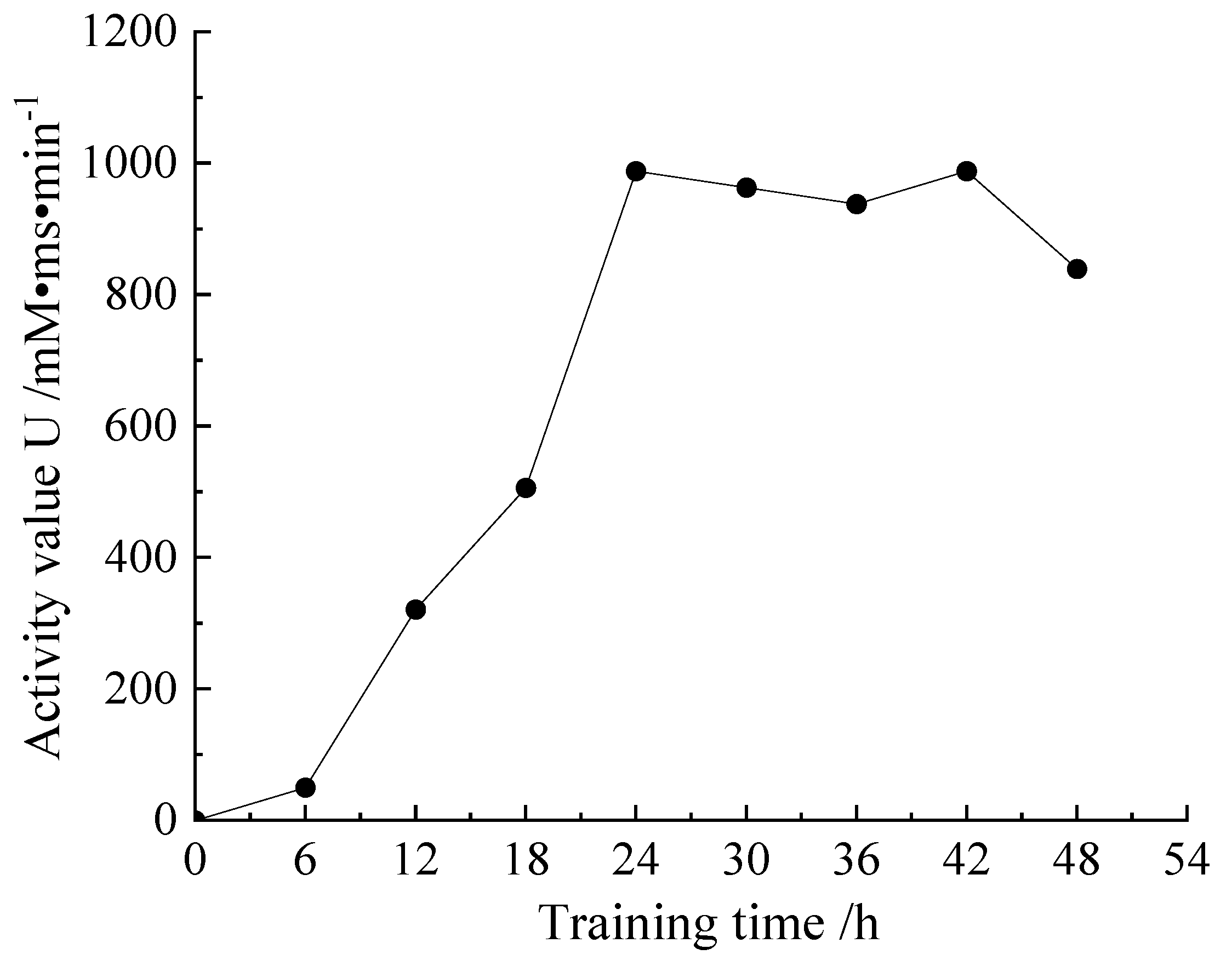
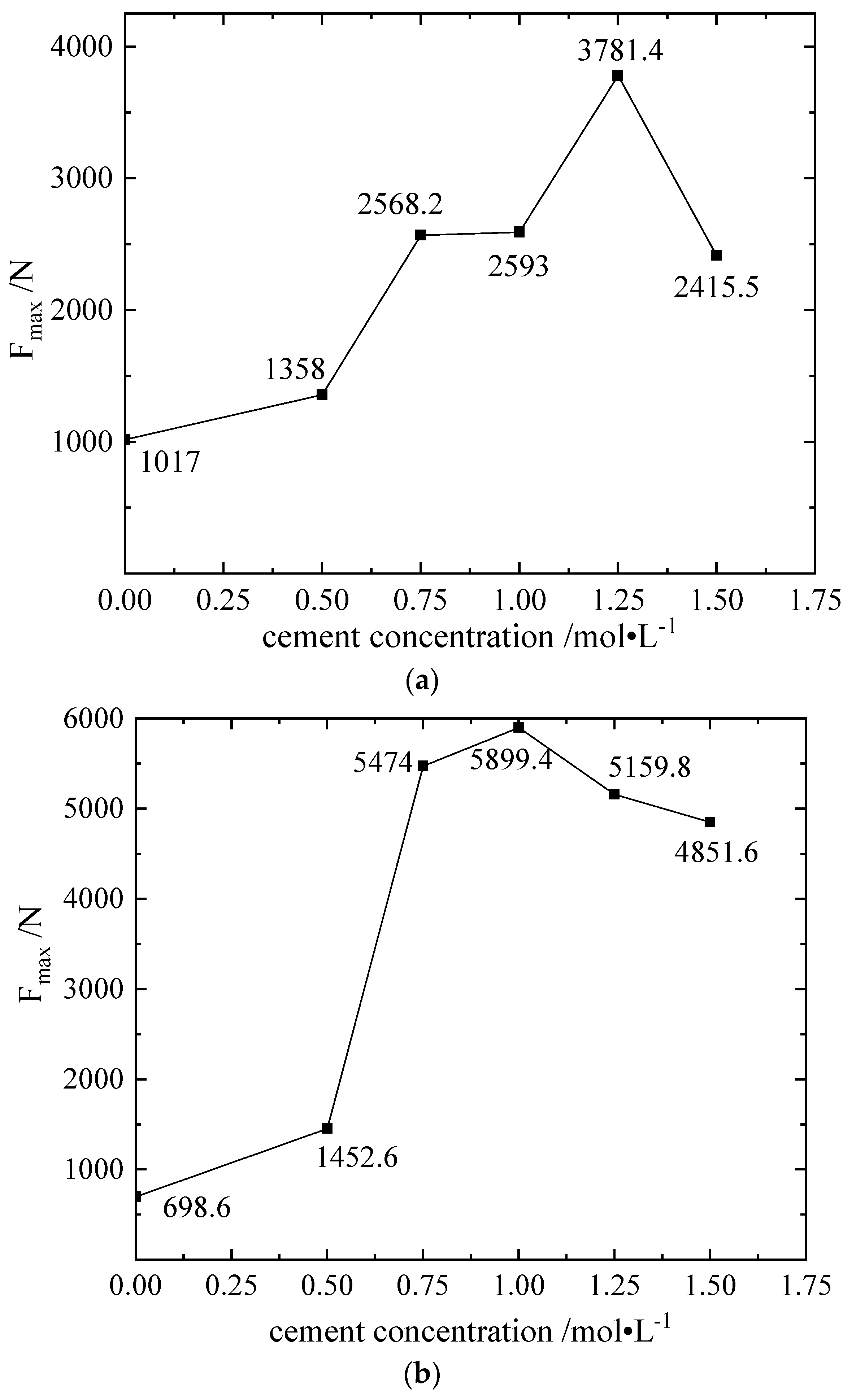

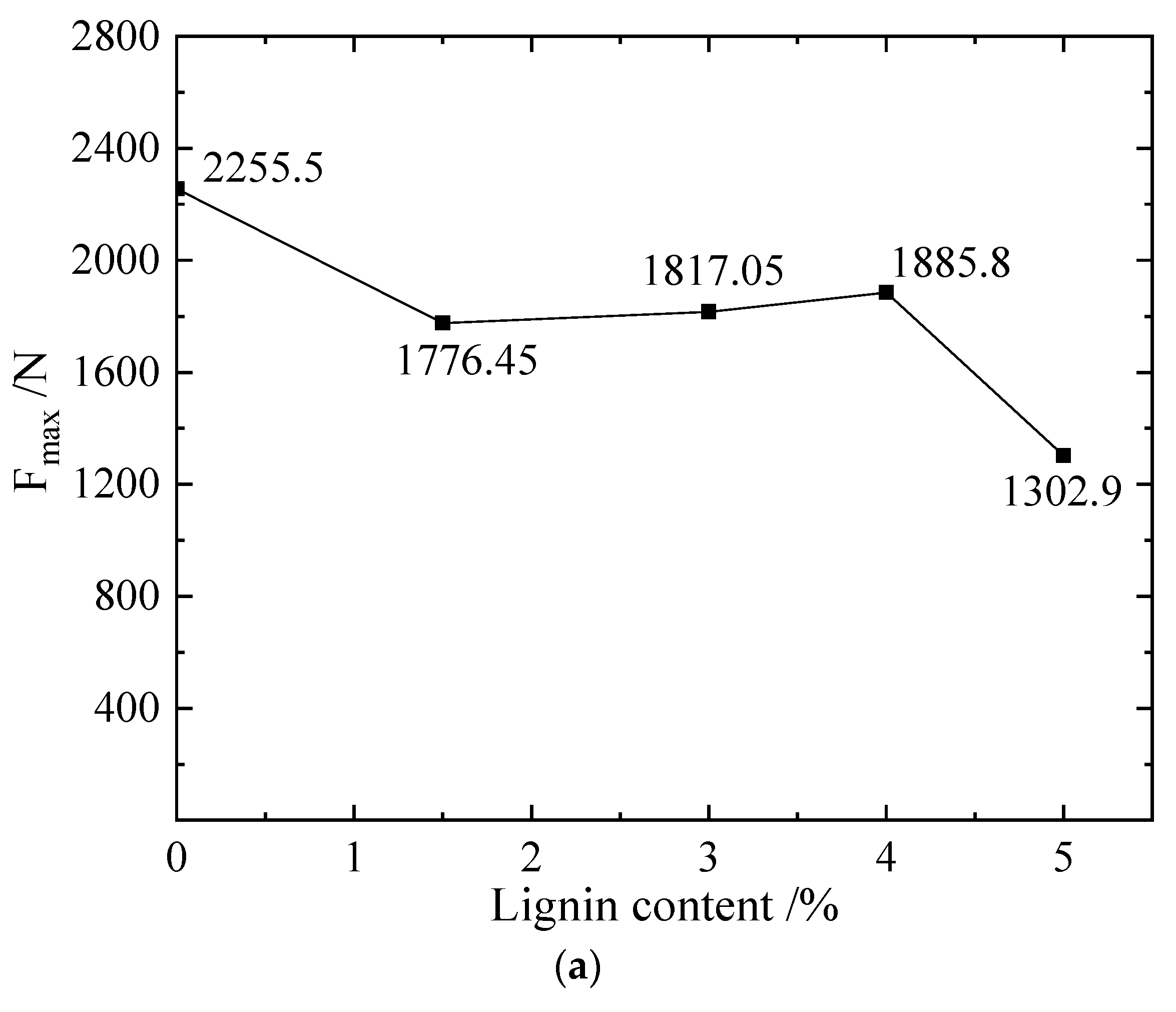
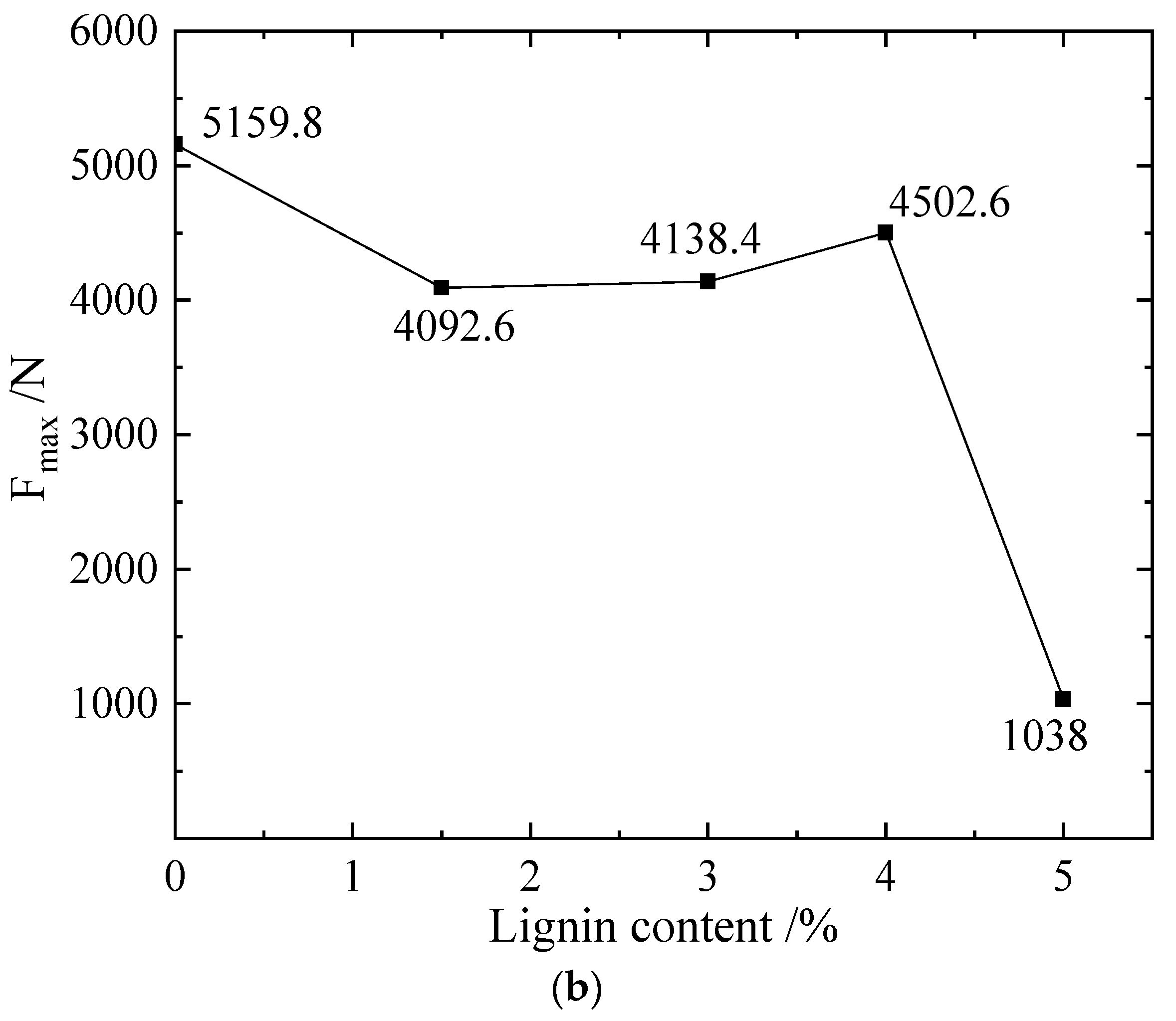
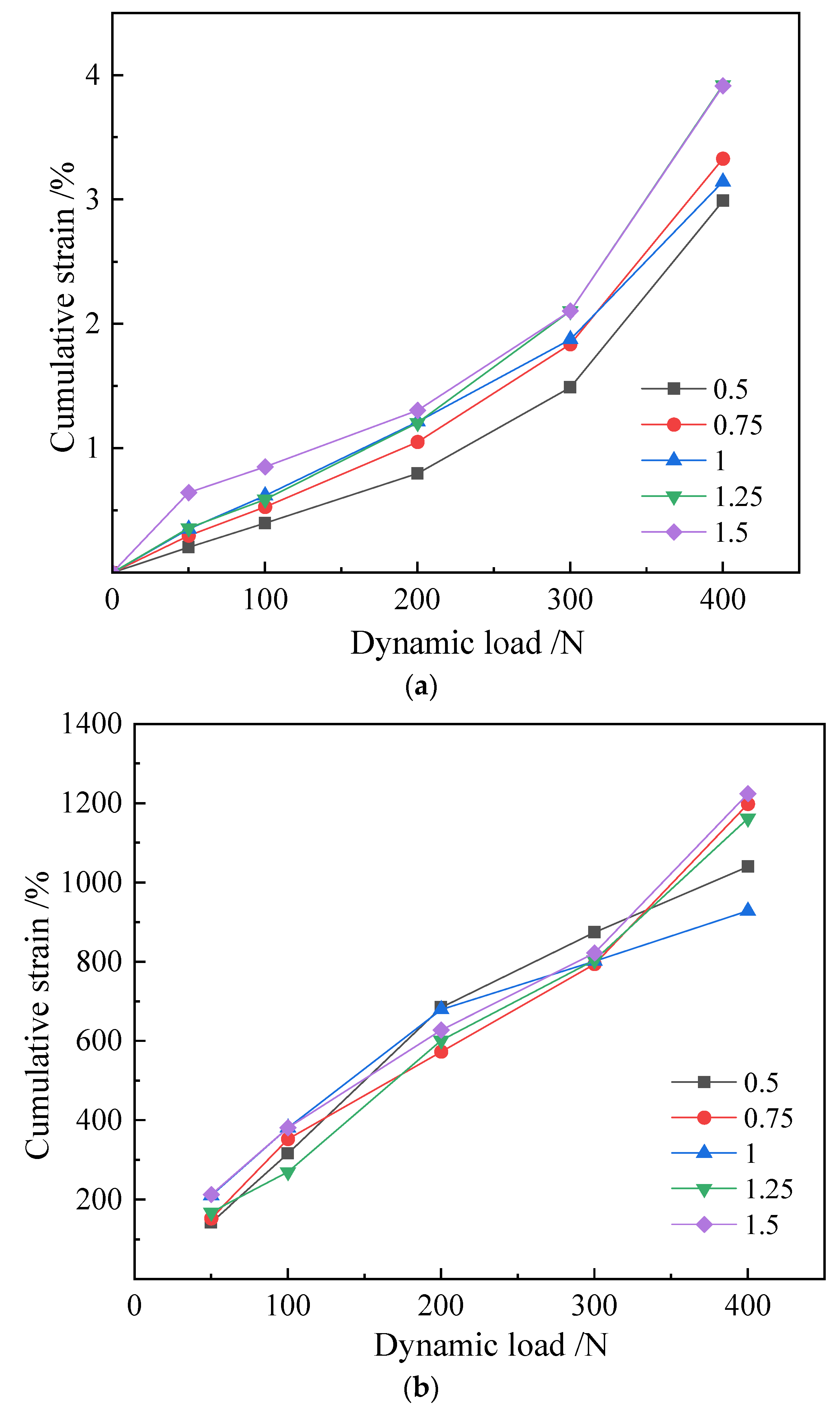
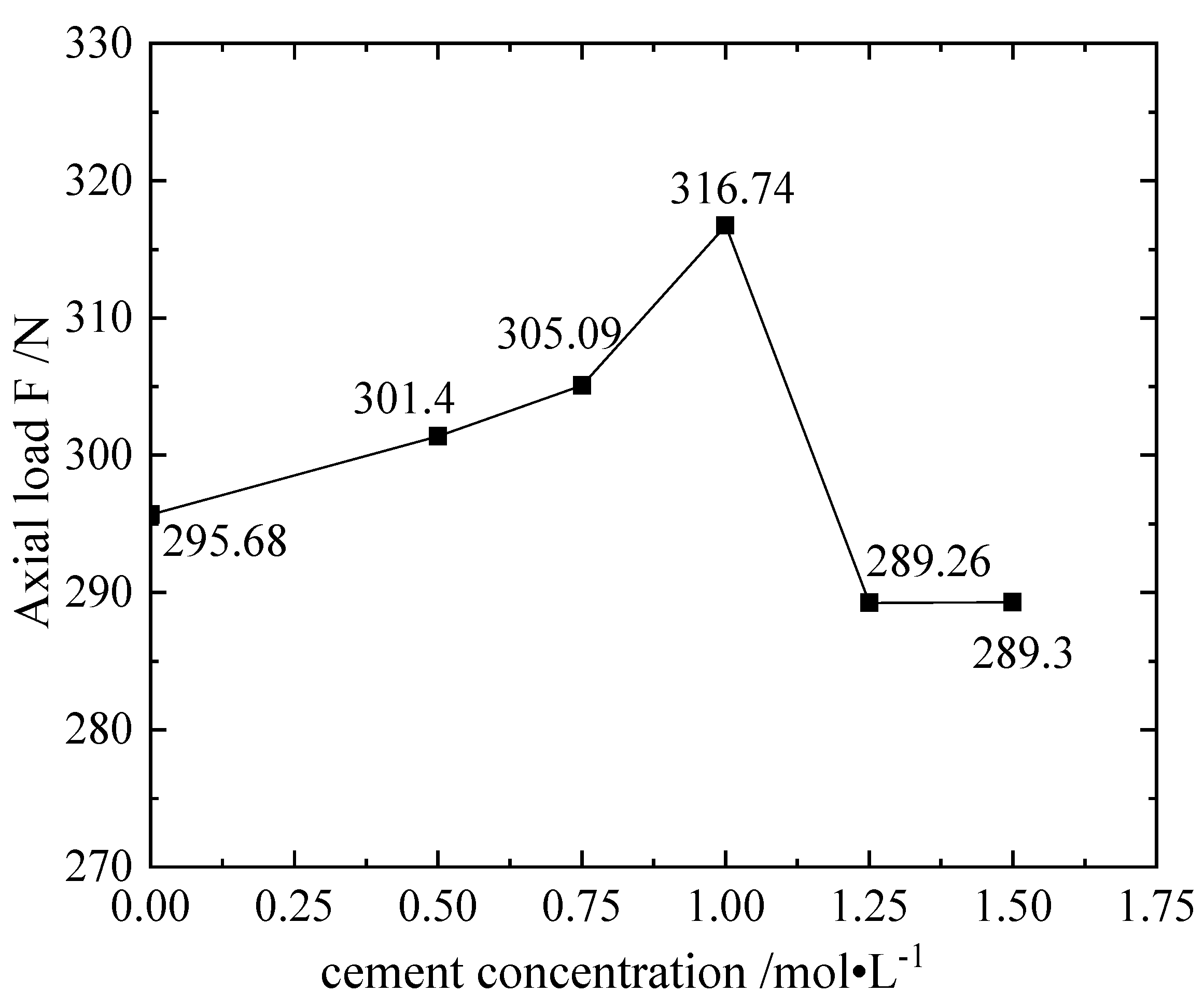

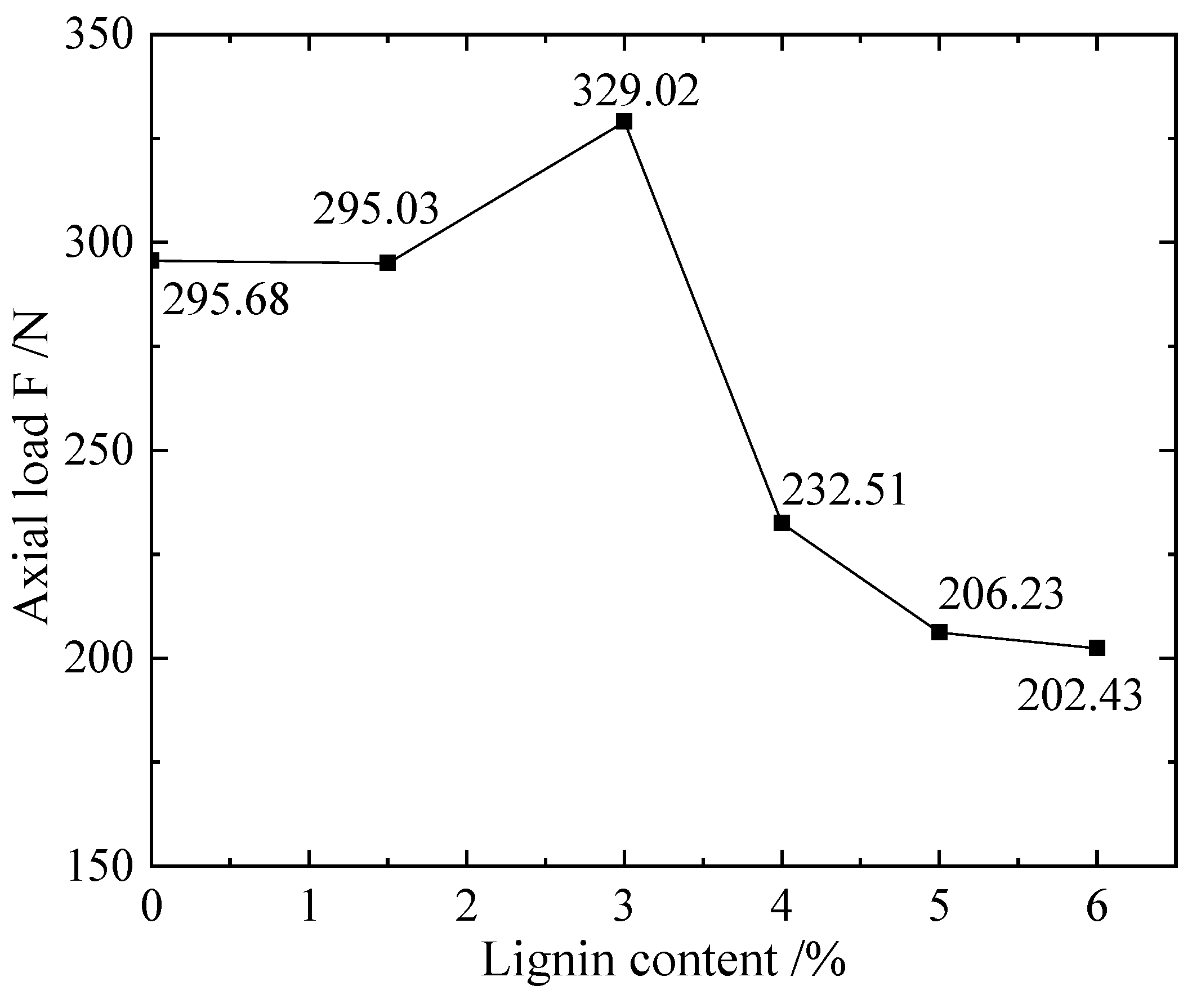
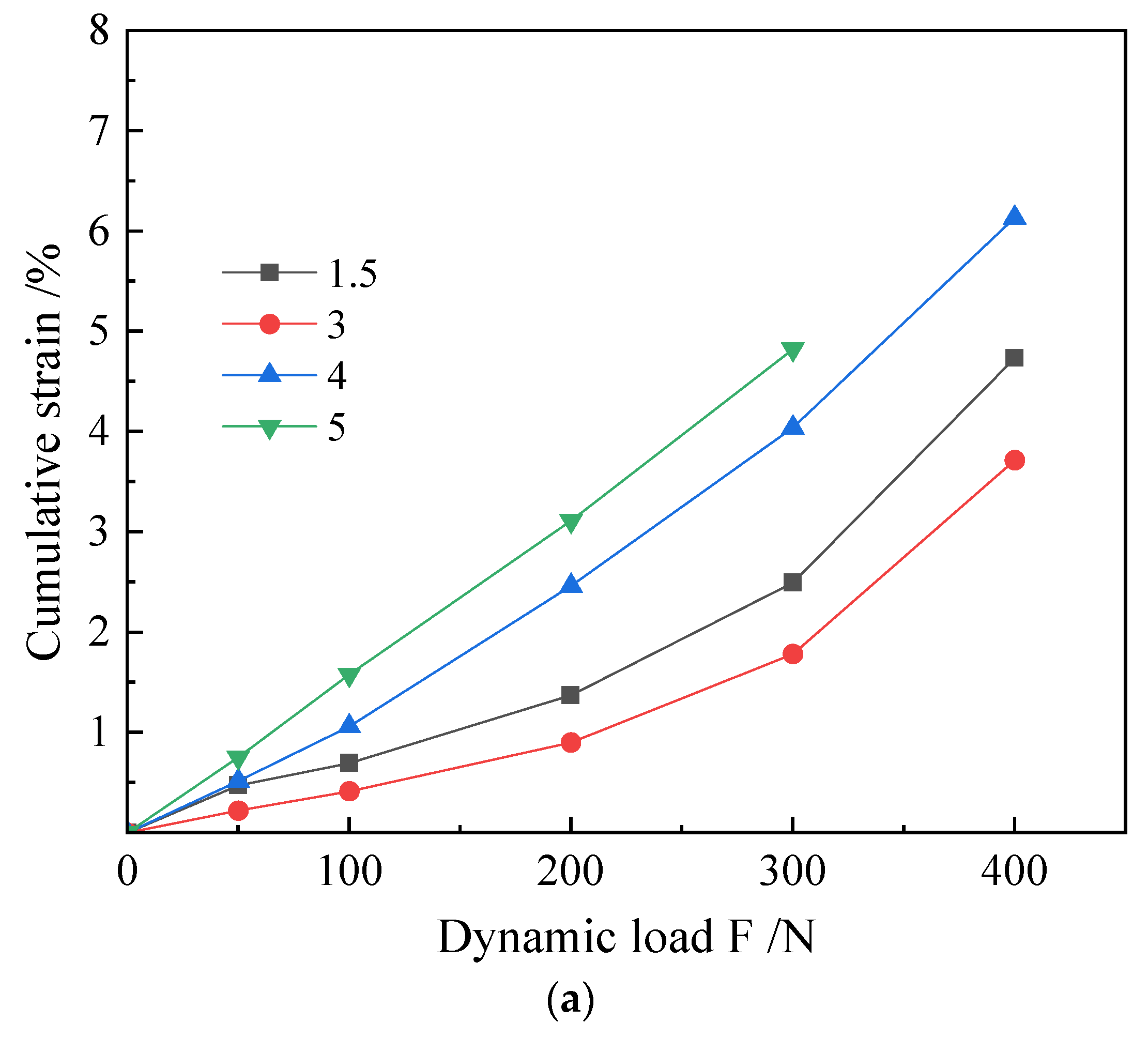

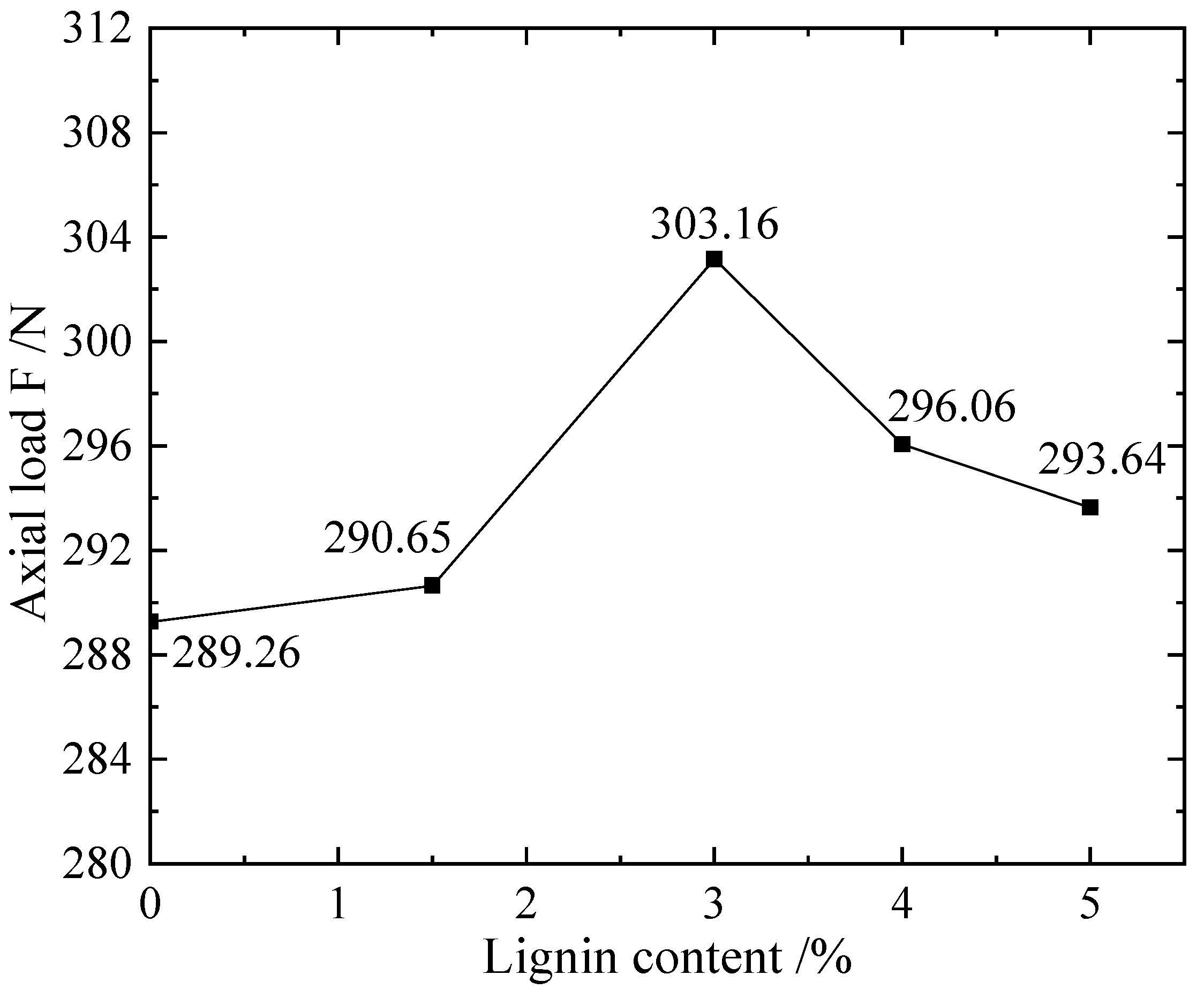
| Soil Sample | Air-Dry Moisture Content W/% | Liquid Limit WL/% | Plastic Limit WP/% | Plasticity Index IP | Grain-Specific Gravity GS | Dry Density ρd | Density ρ |
|---|---|---|---|---|---|---|---|
| Silt | 0.682% | 25.30 | 16.71 | 8.98 | 2.63 | 1.577 | 1.921 |
| Bacterial Liquid | Soil | Cementation Solution | |
|---|---|---|---|
| Unconfined | 48 mL | 160 g | 48 mL |
| Dynamic triaxial | 96 mL | 320 g | 48 mL |
| Concentration mol/L | 0 | 0.5 | 0.75 | 1.0 | 1.25 | 1.5 |
|---|---|---|---|---|---|---|
| Anhydrous calcium chloride/g | 0 | 55.49 | 83.24 | 110.98 | 138.73 | 166.47 |
| Urea/g | 0 | 30.03 | 45.05 | 60.06 | 75.08 | 90.09 |
| The Proportion of Lignin Added/% | 0 | 3 | 6 | 9 | 12 | 15 |
|---|---|---|---|---|---|---|
| Fmax/N | 1017 | 2489.9 | 1401.65 | 1173.28 | 925.9 | 829.8 |
Disclaimer/Publisher’s Note: The statements, opinions and data contained in all publications are solely those of the individual author(s) and contributor(s) and not of MDPI and/or the editor(s). MDPI and/or the editor(s) disclaim responsibility for any injury to people or property resulting from any ideas, methods, instructions or products referred to in the content. |
© 2023 by the authors. Licensee MDPI, Basel, Switzerland. This article is an open access article distributed under the terms and conditions of the Creative Commons Attribution (CC BY) license (https://creativecommons.org/licenses/by/4.0/).
Share and Cite
Sun, Y.; Zhong, X.; Lv, J.; Wang, G.; Hu, R. Experimental Study on Different Improvement Schemes of EICP-Lignin Solidified Silt. Materials 2023, 16, 999. https://doi.org/10.3390/ma16030999
Sun Y, Zhong X, Lv J, Wang G, Hu R. Experimental Study on Different Improvement Schemes of EICP-Lignin Solidified Silt. Materials. 2023; 16(3):999. https://doi.org/10.3390/ma16030999
Chicago/Turabian StyleSun, Yongshuai, Xinyan Zhong, Jianguo Lv, Guihe Wang, and Ruilin Hu. 2023. "Experimental Study on Different Improvement Schemes of EICP-Lignin Solidified Silt" Materials 16, no. 3: 999. https://doi.org/10.3390/ma16030999
APA StyleSun, Y., Zhong, X., Lv, J., Wang, G., & Hu, R. (2023). Experimental Study on Different Improvement Schemes of EICP-Lignin Solidified Silt. Materials, 16(3), 999. https://doi.org/10.3390/ma16030999






